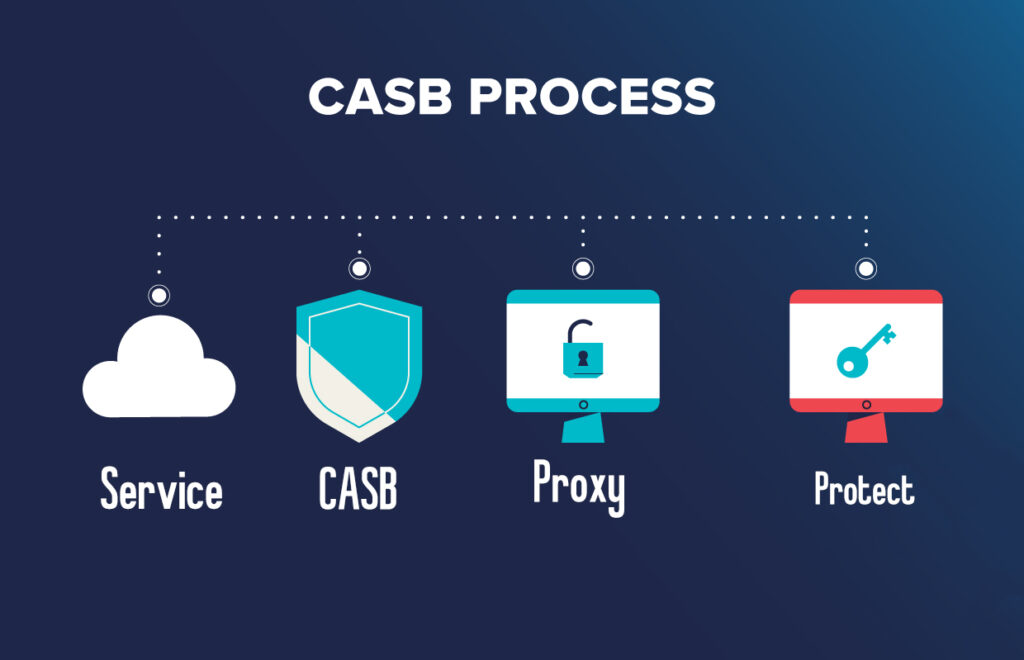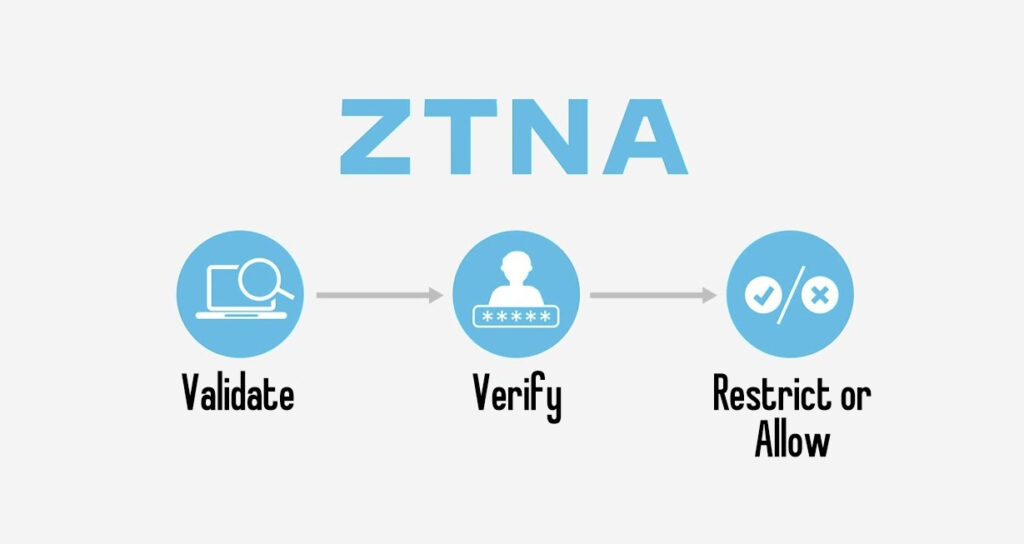Strengths and Weaknesses of CASB, ZTNA, SWG, ATP
As organizations continue to embrace cloud computing and confront the ever-evolving landscape of cyber threats, ensuring robust cloud security has become a top priority. With a wide variety of cloud security solutions available, it is vital to evaluate their strengths and weaknesses to make knowledgeable decisions. In this article, we will explore four key technologies: Cloud Access Security Broker (CASB), Zero Trust Network Access (ZTNA), Secure Web Gateway (SWG), and Advanced Threat Prevention (ATP). By understanding the unique features and limitations of these solutions, organizations can choose the most suitable approach to protect their cloud environments and safeguard sensitive data. Let’s jump into the strengths and weaknesses of each solution.
Cloud Access Security Broker (CASB)

CASB is a security solution that provides comprehensive visibility, control, and data protection for cloud applications and services. It enables organizations to enforce security policies, monitor user activities, prevent data leakage, and achieve compliance within their cloud environments. CASB offers features such as encryption, data loss prevention, and user behavior analytics to ensure the security and integrity of sensitive data accessed or stored in the cloud.
CASB Strengths:
- CASB provides comprehensive visibility and control over cloud application usage, data transfers, and user activities, enabling effective security policy enforcement and data leakage prevention.
- It offers data protection measures such as encryption, data loss prevention (DLP), and access controls, ensuring the security and compliance of sensitive data within cloud environments.
- CASB seamlessly integrates with various cloud platforms, enabling consistent security policies and controls across multiple cloud services and applications.
- The solution utilizes user behavior analytics to detect anomalies, identify insider threats or compromised accounts, and facilitate proactive security measures.
- CASB helps organizations discover and gain control over shadow IT by identifying unauthorized cloud services used within the organization and mitigating associated risks.
CASB Weaknesses:
- CASB implementation can be complex, requiring careful integration with existing systems and applications, which may involve significant planning and coordination.
- CASB primarily focuses on securing cloud applications, offering limited capabilities for on-premises applications or legacy systems.
- Depending on the deployment model and configuration, CASB solutions may introduce latency or impact user experience due to added security measures.
- CASB functionality can vary based on the level of integration and APIs provided by cloud service providers, potentially limiting certain capabilities or interoperability.
- CASB solutions must continually adapt to the evolving cloud technology and threat landscape to provide effective security measures.
Zero Trust Network Access (ZTNA)
ZTNA is a security framework that redefines traditional network access by adopting a granular and dynamic approach. It prioritizes stringent authentication, access controls, and the principle of granting the least privilege to minimize vulnerabilities and thwart unauthorized access attempts. ZTNA allows secure access to applications and resources from any location, without relying on traditional VPNs, enhancing user experience, and reducing the risk of lateral movement in case of a breach.
ZTNA Strengths:

- ZTNA replaces the traditional perimeter-based security model with a granular approach, enforcing strict authentication and access controls to reduce the attack surface and prevent unauthorized access.
- It improves user experience by allowing secure access to applications and resources from any location without the need for a VPN, enhancing productivity and flexibility.
- ZTNA follows the principle of least privilege, ensuring users have access only to the resources they require, minimizing the risk of lateral movement in the event of a breach.
- The solution offers scalability and agility for secure remote access, accommodating dynamic environments and allowing organizations to scale operations seamlessly.
- ZTNA integrates with identity and access management (IAM) solutions, leveraging existing user directories and authentication mechanisms.
ZTNA Weaknesses:
- Adopting ZTNA requires a comprehensive understanding of an organization’s infrastructure, applications, and access requirements, potentially leading to significant changes in network architectures and access policies.
- Integrating ZTNA with legacy systems or applications that do not support modern authentication protocols can be complex and may require additional workarounds.
- ZTNA heavily relies on internet connectivity, making user access to critical resources vulnerable to disruptions or downtime.
- Successful adoption of ZTNA necessitates user education and organizational buy-in to understand the new access paradigm and its benefits fully.
- Implementation of ZTNA may require significant investments in terms of time, resources, and expertise.
Secure Web Gateway (SWG)
SWG is a security solution that acts as an intermediary between users and the internet. It provides URL filtering, content inspection, and malware protection to ensure safe web browsing. SWG enforces security policies to prevent access to malicious websites, filters web traffic, and offers centralized management for consistent security measures. It enhances visibility, control, and protection for organizations’ internet usage and provides secure access to cloud-based applications.
SWG Strengths:
- SWG acts as a security intermediary between users and the internet, providing URL filtering, content inspection, and malware protection, ensuring safe web browsing.
- It enforces security policies to prevent access to malicious or inappropriate websites, reducing the risk of malware infections and data breaches.
- SWG offers visibility into web traffic, user behavior, and data transfers, enabling organizations to monitor and control internet usage effectively.
- The solution can provide secure access to cloud-based applications by inspecting and filtering traffic to and from these applications.
- SWG’s centralized management simplifies security policy enforcement, making it easier for organizations to implement and maintain consistent security measures.
SWG Weaknesses:
- SWG may introduce latency due to the content inspection and filtering processes, potentially impacting user browsing experience.
- The reliance on SWG as a single point of failure necessitates high availability and redundancy measures to ensure uninterrupted internet access.
- SWG’s effectiveness heavily relies on accurate and up-to-date threat intelligence and URL categorization databases, which may require regular updates and maintenance.
- Encrypted web traffic poses a challenge for SWG, as it may limit the visibility and inspection of encrypted content, potentially allowing malicious activities to go undetected.
- SWG’s effectiveness in protecting against advanced threats, such as zero-day exploits or sophisticated malware, may vary, as attackers continually evolve their techniques.
Advanced Threat Prevention (ATP)
ATP is a security solution that leverages advanced techniques, including machine learning and behavioral analysis, to identify and mitigate complex cyber threats. It offers real-time threat intelligence, proactive defense mechanisms, and rapid incident response capabilities. ATP can identify and block zero-day exploits, polymorphic malware, and other advanced threats, contributing to enhanced security posture and threat detection capabilities for organizations.
ATP Strengths:
- ATP employs sophisticated techniques, such as machine learning, behavioral analysis, and sandboxing, to detect and prevent advanced threats that traditional security measures may miss.
- It provides real-time threat intelligence and proactive defense mechanisms, enabling organizations to stay ahead of emerging threats.
- ATP can identify and block zero-day exploits and polymorphic malware by analyzing their behavior and characteristics.
- The solution offers rapid incident response capabilities, allowing organizations to quickly mitigate and contain threats before they cause significant damage.
- ATP solutions often integrate with other security tools and platforms, enhancing overall security posture and threat detection capabilities.
ATP Weaknesses:
- ATP solutions can be resource-intensive, requiring robust hardware infrastructure and computational power to handle the analysis of large amounts of data.
- False positives and false negatives are inherent challenges in ATP, as the complexity of advanced threat detection may result in misidentifications or missed detections.
- The constant evolution of advanced threats requires regular updates and maintenance of ATP solutions to ensure their effectiveness.
- ATP solutions may have a learning curve and require expertise to configure, manage, and interpret the results accurately.
- The cost of ATP solutions and ongoing subscription fees may be prohibitive for some organizations, particularly smaller ones with limited budgets.
Conclusion
Understanding the strengths and weaknesses of cloud security solutions such as CASB, ZTNA, SWG, and ATP is crucial for organizations to make informed decisions regarding their cloud security strategies. Each solution offers unique capabilities and addresses specific security challenges. By carefully evaluating these strengths and weaknesses, organizations can select and implement the most suitable combination of technologies to protect their cloud environments, safeguard sensitive data, and mitigate evolving cyber threats.
Take the Next Step! Please call 866.421.9522 to schedule a meeting with one of our industry experts.
USAccess LLC
Copyright © 2023. All Rights Reserved
